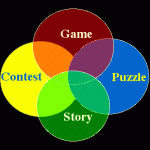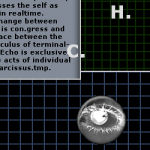2004
Pat Harrigan and Noah Wardrip-Fruin introduce Cyberdrama, the first section of First Person.
Espen Aarseth foresees the quick end of Murray's "story-game hybrid" and suggests instead a "critical theory of games."
Moving from the holodeck to the game board, Janet Murray explains why we make dramas of digital simulations.
Secret agency is at issue in Frasca's response, which denies the application of Aristotle to the open-ended interactivity of gaming.
In response to Perlin, Victoria Vesna reiterates the unique realism of games.
The man behind The Sims, Will Wright, places narrative controls back in the hands of gamers.
Sidebar images from "How I Was Played by Online Caroline."
Sidebar images from "Metaphoric Networks in Lexia to Perplexia."
A thirst for interaction fuels Adrianne Wortzel's response.
Bill Seaman hyphenates the "hybrid-languages" of Lexia to Perplexia.
Brenda Laurel takes a turn at the rules of operation for Interactive Fiction.
Eugene Thacker's question: "To what degree does language account for the markers and meanings of embodied difference?"
Janet Murray unriddles the verbal and procedural mix of Interactive Fiction.
"Thinking around the responses," Jill Walker reconsiders how gender and identity influence the reader-reading-the-reader in Online Caroline.
A response that bridges things, as metaphors do.
Nick Montfort reiterates the value of multiple perspectives on, and in, New Media.
Warren Sack sheds some psychosocial light on readings, like Jill Walker's, of the uncanny.
Lucy Suchman's directive for talking things: "the creative elaboration of the particular indexical affordances of machine 'speech.'"
Natalie Jeremijenko asserts that machine speech should re-awaken us to "the peculiar structure of participation that we take for granted."


